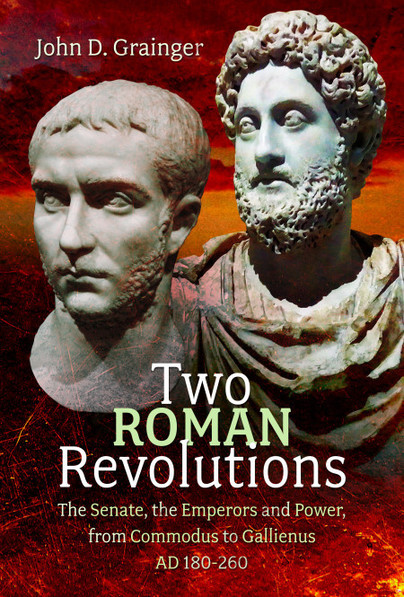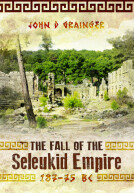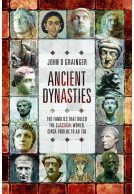Two Roman Revolutions (Hardback)
The Senate, the Emperors and Power, from Commodus to Gallienus (AD 180-260)
Imprint: Pen & Sword Military
Pages: 256
Illustrations: 16 mono illustrations
ISBN: 9781399037181
Published: 18th March 2024
(click here for international delivery rates)
Order within the next 4 hours, 2 minutes to get your order processed the next working day!
Need a currency converter? Check XE.com for live rates
| Other formats available - Buy the Hardback and get the eBook for £1.99! | Price |
|---|---|
| Two Roman Revolutions ePub (4.0 MB) Add to Basket | £6.99 |
The disastrous reign of the Emperor Commodus, which saw a great expansion of the power of the emperor, eventually resulted in his assassination, but also in a civil war, which was as revolutionary as that of 69. Though the original assassination had been in the name of a restoration of the authority of the Senate - the programme of Pertinax and his supporters - the victory of Septimius Severus established a murderous autocracy, which degenerated into incompetence under his successors. It also set up a continuous tension within the government between imperial and senatorial powers and authority.
The weakness of the imperial power after Caracalla was emphasised by the assassination of all emperors between 217 and 238; it also produced an increase in warfare on all frontiers from Syria to Britannia. In the later years of Alexander Severus the Senate began to recover its authority, thanks to the emperor's long absences from Rome in the east and in Germany. His frontier policy displeased the army, however, and his assassination produced the Emperor Maximinus. The recovery of the Senate was immediately stopped in its tracks and Maximinus disdained all authority apart from his own.
This was a classic prerevolutionary situation, and the reaction amongst the senators was the revolution of 238, sparked by trouble in Africa under the Gordians, but also producing another civil war and the deaths of several emperors. The authority of the Senate was enhanced by the senatorial victory but in in the end the Senate proved unable to defend the empire, and the contest between imperial and senatorial power continued until the 260s when in effect Gallienus returned to imperial autocracy.
This marked the end of real senatorial power, and the empire as an autocracy was finally established.
A seminal and ground breaking study, "Two Roman Revolutions: The Senate, the Emperors and Power, from Commodus to Gallienus (AD 180-260)" by historian John D. Grainger is informatively enhanced for the reader's benefit with the inclusion of a number of Maps and Illustrations, seventeen pages of Notes, a four page Bibliography/Abbreviations, and a six page Index. As an historian so well versed in the history and personalities of the Roman Empire, and a prolific writer, Granger has a positive knack for presenting history in an especially compelling and informative style that will be greatly appreciated by both scholars, students, and non-specialist general readers with an interest in Roman history. While unreservedly recommended as a core addition to personal, professional, community, and college/university library Roman History collections and supplemental curriculum studies lists, it should be noted that "Two Roman Revolutions" is also readily available in a digital book format.
Midwest Book Review
Read the full review here
A well researched and informative book about a chaotic and less know time of the Roman Empire. It made me learn something and I appreciated the style of writing.
NetGalley, Anna Maria Giacomasso
Recommended.
Rating: 5 out of 5 stars
NetGalley, Kathryn McLeer
I really enjoyed reading this book, it had that history element that I was looking for and enjoyed about nonfiction books. I enjoyed getting to learn more about Roman and their Emperors. It had everything that I was looking for and enjoyed the way John D Grainger wrote this.
This book explores the demise of Roman senatorial power and the empire’s transition into a full-fledged autocracy in the eighty years after the death of Marcus Aurelius. The book is well-researched fairly easy to read. It provides an interesting analysis of the sociopolitical changes that took place during this time period.
NetGalley, Andrea Romance
Rating: 5 out of 5 stars
NetGalley, Nathan Uglow
This is a study of the 3rd century crisis when the Roman Empire experienced a range of pressures that nearly caused it to buckle. The system of governance was simply insufficient for the size and scale of the empire and the emperor, senate, and army came to grind against each other violently. The emperors sought to wrench themselves free of a senate whose status outstripped their use value. The army faced pressures on every border and decided to seize the resources it needed to do its job properly.
Grainger charts the period of, roughly, 180-280, in terms of these internal tensions and conflicts. It was a period when emperors came and went rapidly, particularly in the years 197 and 238. These two single years are cast as a kind of breaking fever, with the internal balance of the Roman government (imperial court, senate, and army) being recast each time. These are the two ‘revolutions’ of the title – not revolutions from below but revolutions from above.
It is a narrative history, but the narrative is focused on demonstrating that idea of the two revolutions. The first 7 chapters explore the decline and fall of the emperor Commodus (that mad emperor from Gladiator) and the messy aftermath. There is a kind of second half, with a sort of fresh introduction, for the chaotic decades-long crisis that started in 238.
Grainger has set himself the task of charting how Roman governance got itself from the early Caesars to the much more bureaucratic and ceremonial state machine that Diocletian and Constantine constructed. There are many gaps in the record and these require informed speculation to plug; this is where the author’s particular skill set lies. The book is perhaps best described as ‘forensic’. As such, it is the story of the leading political and military figures, many of them are named and whose social relations and biographical details reconstructed (a method called ‘prosopography’). It is not the blood-and-guts version you get in Harry Sidebottom’s Throne of the Caesar trilogy of novels. Grainger’s style is both drier, but also more patient, detailed and yet for all that surprisingly clear.
It is safe to say this book is unrivalled. There are quite a few military histories of the period and some that chart the sequence of emperors, but I can’t think of another book that really covers the political and institutional history of the period like this. I’ve already gone on too long, but it is worth adding that Grainger is a real gem and his contribution to my own understanding of the ancient world, across his many, many books, has been huge. So, author – many thanks.
About John D Grainger
JOHN D GRAINGER is a former teacher and historian of great experience with a particular interest in Classical and Hellenistic Greek history. His many previous works include the following for Pen & Sword: Hellenistic and Roman Naval Wars (2011); The Wars of the Maccabees (2012); Roman Conquests: Egypt and Judaea (2013); a three-part history of the Seleukid Empire (2014-16), King’s and Kingship in the Hellenistic World 350-30 BC (2017), Antipater’s Dynasty (2018), Ancient Dynasties (2019, The Roman Imperial Succession (March 2020), The Straits from Troy to Constantinople (2021) and The Forty Sieges of Constantinople (2022). He lives in Evesham, Worcestershire.





















